Bake Off for glassblowers: meet the British winner of Netflix’s hit series Blown Away
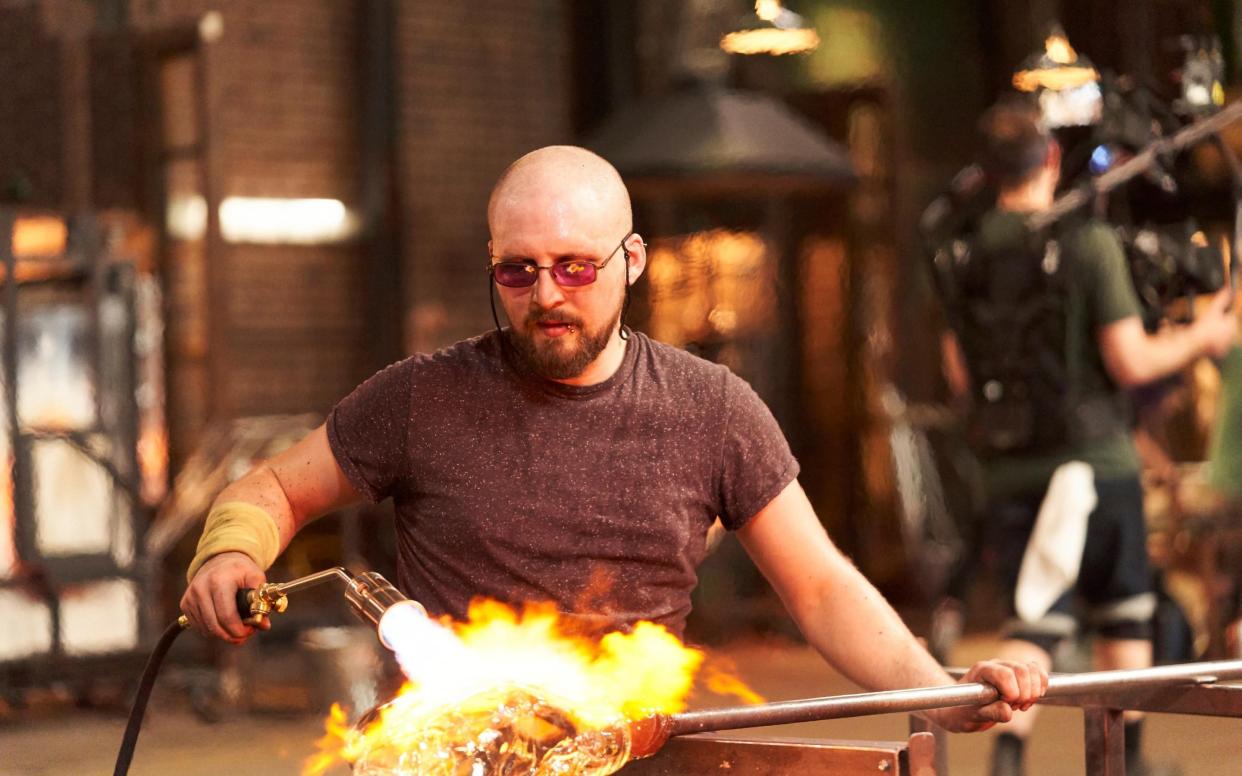
Elliot Walker, the 32-year-old British artist and winner of season two of Blown Away, Netflix’s bizarre and addictive glassblowing contest, came very close to not applying to be on the show at all.
The self-described “random Brit” amongst a predominantly American contestant pool, he found himself squeaking in an application just under the deadline. “I was so reluctant to apply, it was everyone around me who was trying to nudge me into it” he tells me over the phone from his studio outside Hertford.
“By nature, it’s not the sort of thing I’d normally go for. It meant putting yourself out into the world in quite a direct way and I’m fairly introverted and have never been that competitive. But in the end, my girlfriend and my studio assistant pushed me over the final hurdle to do the application.”
Thank goodness they did, for without him, Netflix’s least likely sounding hit of the last six months would lack its latest super star. “You’re about to be blown away” puns the dramatically cheesy opening voiceover, which introduces the viewer to a competition format that takes 10 artists, one enormous abandoned warehouse in Canada, and a hefty dose of dramatic string music, to find the very best… glassblower.
The first season landed with little fanfare in July in the midst of the pandemic but it soon developed something of a cult following. Vulture named it “your go-to summer reality competition” and #gloryhole (the technical term for the plus-1000℃ degree furnace in which the glass is melted) became an instant Twitter trend.
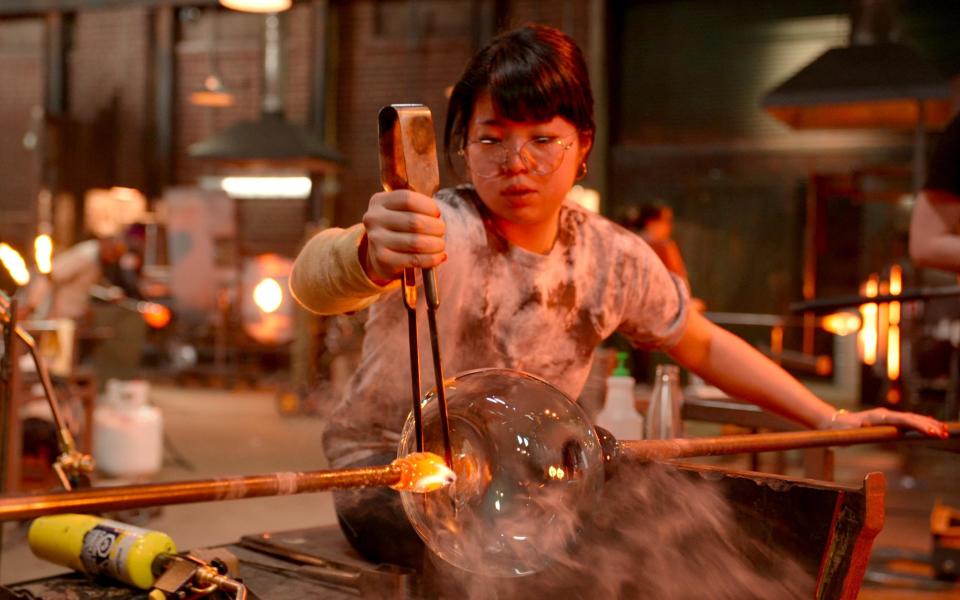
“When we were making the show there were a few snickers in the edit suite” producer Matt Hornburg tells me, over the phone from his home in Ontario, of the colourful term. “But it was like, well, that’s what they’re called. It never occurred to me it would fuel interest.”
But there was more to the show’s appeal than its memeability. People for whom glass had never meant more than a drinking vessel found themselves suddenly captivated by the sight of this alien molten material being puffed and twisted into strange and beautiful shapes. Some were even inspired to try it themselves: glassblowing schools like UrbanGlass in Brooklyn saw an uptick in bookings from people who had watched Blown Away and decided to try their hand (and lungs).
The show piggybacked onto a resurgence in popularity for handmade glass. Since the late twentieth century, independent glass studios had begun to emerge, particularly in America, into the vacuum left by the decline of the traditional glass industry. The craft’s particular blend of rough-hewn physicality and creative delicacy appealed to a certain beardy hipster sensibility. Blown Away was smartly opportunistic.
The idea for the show was first pitched to Hornburg and the team at his production company Marblemedia by an intern at a meeting exploring few reality formats. Its potential was immediately apparent to him. “Glassblowing is so visually appealing, plus there are the elements of fire and danger and fragility.” At the time, he also felt there was an appetite for a new kind of reality competition. “I think audiences were craving something that felt a little bit new. There had been a lot of food shows…”
The team at Marblemedia developed the idea and took it around a number of channels and streaming services, but Hornburg always felt that Netflix would be their best chance. “Very visual mediums, kind of aesthetically striking shows tend to work for them, if you look at cornerstones like Chef’s Table, things like that.”
Once Netflix had given Blown Away the greenlight, they had to go about constructing what the show proudly introduces as North America’s biggest hot shop. “We only did that because we had to,” Hornburg says wryly. “We needed the raw space and we also realised that being in a formal TV studio would probably be too complicated from the insurance perspective. Plus it wouldn’t really have felt organic or true. We wanted a very authentic experience for both our audience and the glassblowers.”
With the help of Koen Vanderstukken, head of the glass programme at Canada’s Sheridan College Institute of Technology and Advanced Learning, who was on a sabbatical at the time and came onto the show as an advisor, the production team took over an enormous, brutalist-looking abandoned warehouse in the town of Hamilton, Ontario and set about transforming it into a glassblowers’ paradise.
They added 10 furnaces, capable of heating to over 1000 degrees celsius, as well as all the other specialist equipment glassblowing requires, objects with deliciously exotic-sounding names like “annealer” (a kind of slow-working fridge that cools down freshly-moulded glass in a way that won’t shatter or damage it) and “punty” (a metal rod which holds the glass in place while it's shaped).
Unsurprisingly, a project as ambitious as a giant hot shop did not come without its challenges. “In the first episode of the first season, we had a lot of people suffering from heat exhaustion” Hornburg tells me. Alarmed, he brought in dozens of extra air conditioners, hydration facilities, and opened the roof, after which they had no more problems (although the amount of sweat caught on camera in the show rivals a professional sports match; at one point, a contestant takes a pair of scissors and chops off most of their trouser legs).
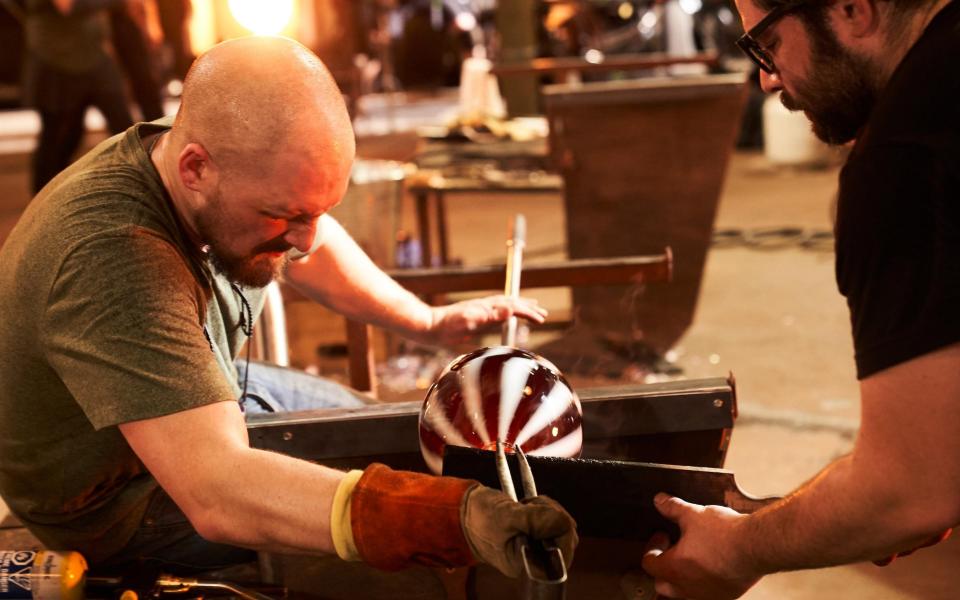
“Sometimes if something hasn’t been done before, there may be a good reason for it” says Hornburg ruefully. “Once you’ve actually completed something that feels very ambitious, you look back and are so thankful that you actually didn’t know what you didn’t know.”
This season, the show widened its field of contestants across national boundaries, which is how Walker ended up on it. The second stage of the application involved a video interview screen-test, which, Walker tells me with a chuckle, he did not think had gone particularly well. “I had just got in from work, and I haven’t got great tech or anything, so it was quite difficult for the interviewer to see me, and I was covered in ash and grime from the day.
“The interviewer asked me, ‘Can you wipe your lens to make it a little bit cleaner?’ because my phone is always in my pocket while I’m working and it gets covered in dirt and sweat, so I wiped my thumb across it and just made this big black smudge all the way across the screen, and I was like ‘Sorry, that hasn’t really helped has it?’”
But for all his self-deprecation, Walker clearly impressed the producers. Unlike the American contestants, most of whom came from the thriving glassblowing hubs of Seattle and New York, he is largely self-taught. While studying for a BA in psychology at Bangor University he began creating stained glass windows and became utterly transfixed by the material. In Dudley – historically the centre of Britain’s glass and crystal-making industries – Walker made his way onto a one year glass course at a local art college. There, he learned the basic (and ancient – glassblowing dates back to the Romans) technique: sand, lime, and soda are thrown into a furnace where they form molten glass, then gathered onto the end of a punty and blown into a bubble, to be twisted and shaped into sculpture using pliers, pincers, and blow torches, before being reheated, re-shaped, coloured, and slowly cooled. Walker attributes much of his present skill to that single year of study: “[The course] trains you in all the aspects of glass, in the making and the cutting. It was amazing.”
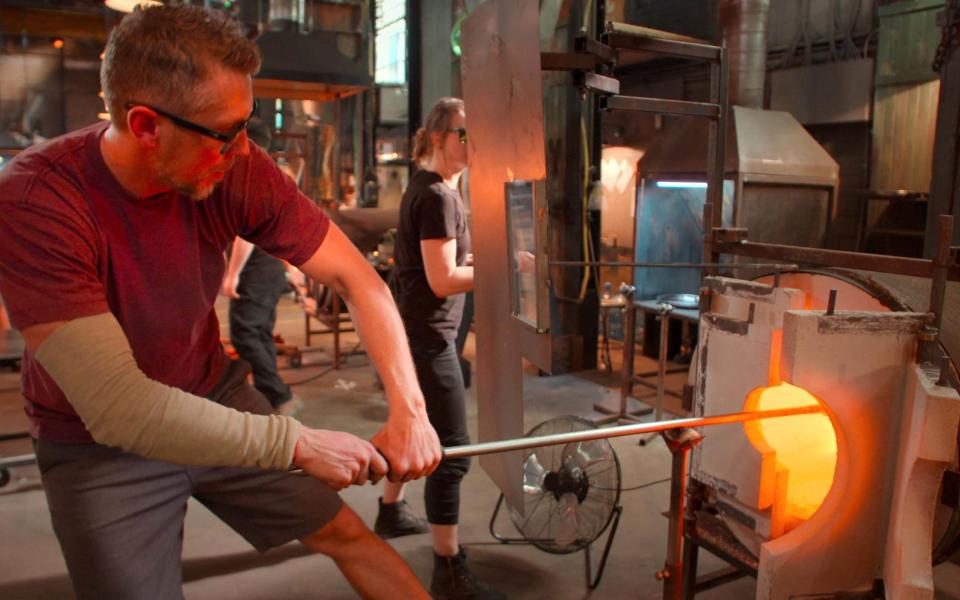
What it could not prepare him for, however, was the bizarre experience of Blown Away. He was given a week’s notice when the show began shooting and spent a hectic few days finishing off a “massive, massive commission” for a lighting company and organising delivery of the furnace he had just bought from Vienna, before flying out to Toronto for what turned out to be seven weeks. On arrival, all the contestants were isolated in separate hotel rooms for three days, with food delivered to the door (and no, this was not a covid security measure – the show wrapped shooting in mid March, mere days before most of Canada went into lockdown), before being taken into the green room blind folded, in order to avoid contestants recognizing each other before the cameras rolled.
“Everybody knows everybody in the glass scene in America,” explains Walker. “I think the producers were worried that people would, you know, start plotting.”
Did he feel like an outsider, the sole Brit, and the only contender not permanently based in the US? “I was always going to be...” he considers, “not separate, but an underdog.” He contends that some of the student assistants provided to help the contestants complete their challenges within the tight time frames had more technical glassblowing knowledge than he did – given his performance in the show, this is somewhat strains credulity, although he does seem to sustain a particularly high proportion of the breakages in the early episodes. However, any lack of technical training certainly does not hold him back as the season continues.
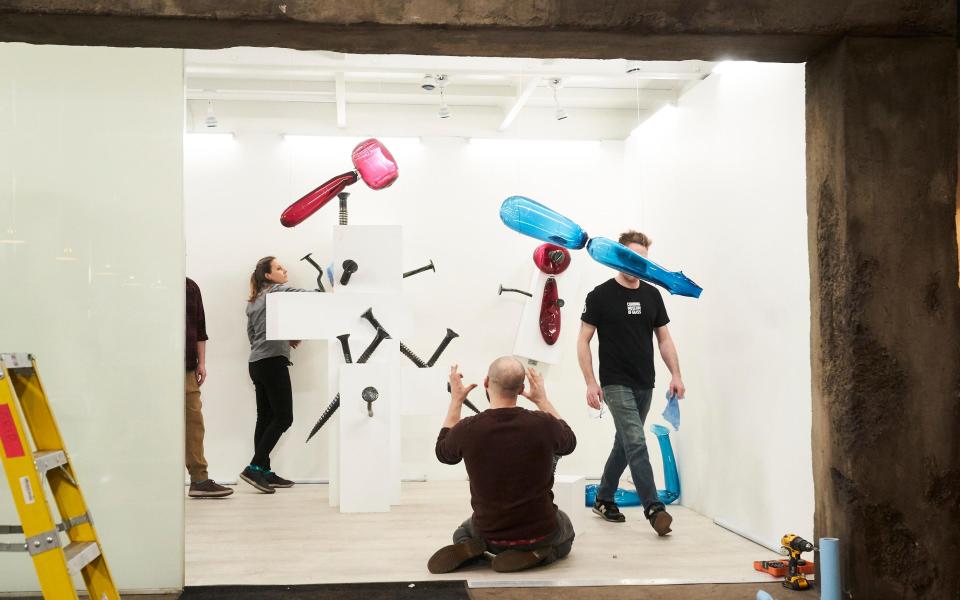
Perhaps it helps that inside the hot shop, Walker keeps a cool head. When it comes to the pressure that the format works hard to pile on the contestants, he seems fairly flame retardant. “Working with glass, you don’t really need to try that hard to manufacture disaster” he says. In forcing such a fragile material through such drastic form and temperature changes in such short periods of time, success is always precarious.
“Every day in the studio, something is broken, something has crashed to the floor, someone has stuck a piece of glass to the door of the furnace and ripped it off.” Barely an episode goes by without a couple of spectacular breakages: a giant insect falls off the punty and shatters, countless bubbles and bowls lie in smithereens across the floor, to be met with varying degrees of sweaty fury from their creators.
Walker, however, rarely looks anything but sanguine – his brisk cries of “lovely jubbly!” are an amiable backdrop to the season. “Every day there is a calamity of some sort. It’s how you deal with that, you know? You learn to accept failure quite a lot. So when we did break things on the show, they really wanted us to sort of express some sort of emotion. But to be honest, when you break a piece of glass, normally your emotions don’t come into it, because you’ve done it 17 times before. Calamity is all part of the process.”
He does concede, however, that at times, the pressure got to him. “You always have in your mind that ‘This is my one shot. I have to do it right.’ It’s very, very intense.”
When I ask how he feels about the art he created on the show, he is unsentimental. “I think the thing to remember when you watch the show is this isn’t how people make artwork. It’s not how you would decide to make a piece of sculpture or a top quality piece of work. You wouldn’t [as the show does] deliberately put yourself under the maximum amount of pressure.”
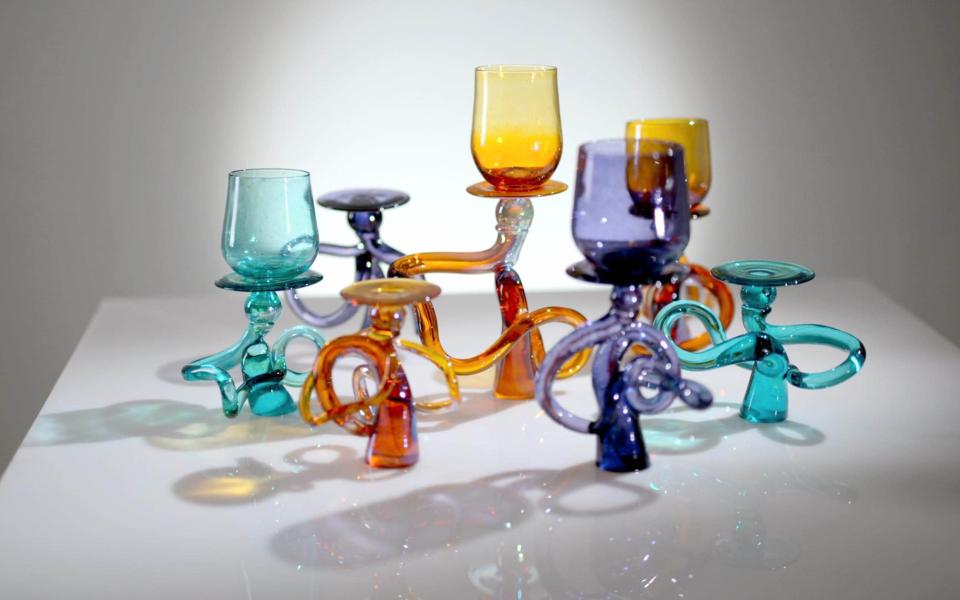
But there were what he poetically terms “some moments of grace. Sometimes the conditions are right, and the glass does what you want it to do, and you make the right movement, in the right mood, and you can make something in one session that you’d never would have been able to repeat or replicate because it’s such a fluid medium. Yes, there were definitely moments of grace.”
His winning piece, Bodge Job – a child’s fantasy tool collection of giant rusting nails, and inflatable fairground hammers and screwdrivers – won over the judges with its winning blend of technical nous and playful vulnerability.
He says he “couldn’t be more thrilled at winning the series, but more importantly having met all the other contestants! An experience like this is very bonding and now I can say I have friends from all over the world.”
He hopes his “small victory” will mean that “the glass art scene in the UK receives the boost and acclaim it so desperately needs.” The glass course at Dudley College where Walker learned the basics of his craft no longer exists – in fact, officially, it had been discontinued the year before he arrived. Such erosion of educational resources reflects Dudley’s long term decline as the once thriving centre of the British glass industry. By the 1990s, nearly all the major crystal works in the area had closed down. And since Broadfield House, the country’s only dedicated glass museum, closed in 2015, there has been precious little museum funding to acquire contemporary work and no government support for the industry.
“It just needs showing off really, because there are some fantastic people at work, and they really need a platform” he tells me. His victory is certainly grounds for optimism. Thanks to Blown Away, glassblowing in this country might just be about to blow up.

